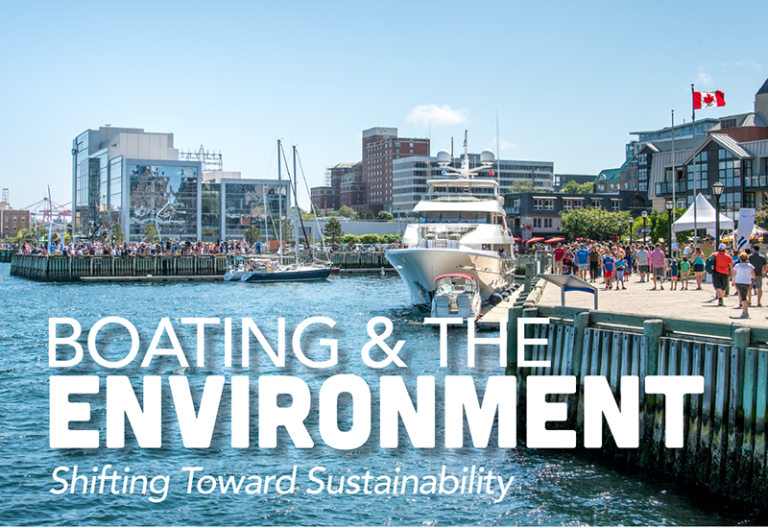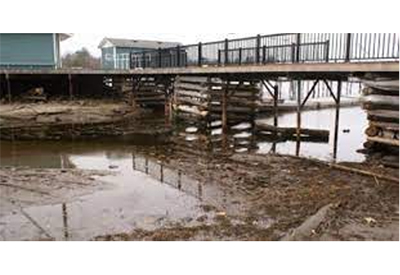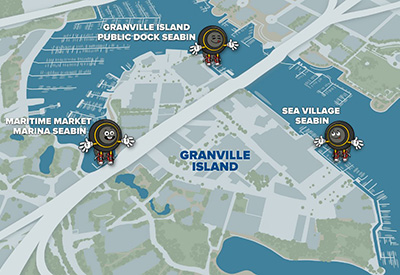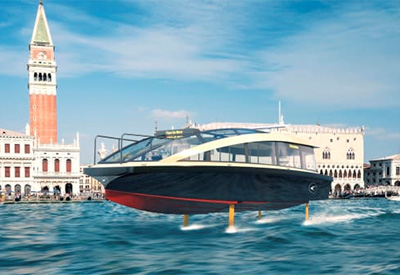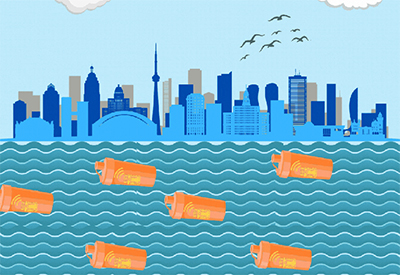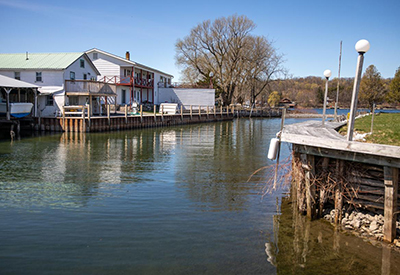Asian Carp: A New Challenge for the Great Lakes
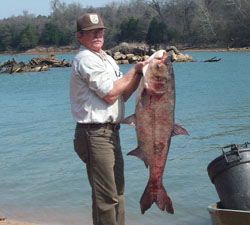
Zebra muscles, lampreys, fertilizer runoff, chemicals, low water levels. The list of challenges facing the Great Lakes is a long and worrisome one. Many thousands of people depend on the health of the lakes for their livelihood and many millions are directly affected by their condition. Now the Great Lakes may be on the verge of playing host to some new and unwelcome guests. The Asian Carp are on the move and a lot of people are very worried indeed. Although the carp’s jumping antics have made it a You Tube star, it is their voracious appetite and efficient breeding that have many environmentalists, fishermen and recreational industry experts fearing the worst. That the Asian Carp represent a threat to the lakes is not in dispute, but just how much of a threat and what to do about it, is hotly contested.
Asian Carp?
While all of the seven types of carps found in North America were introduced at different times beginning in the early 1800s, it is the most recent imports that are causing all the concern. The term “ Asian Carps” refers to four species: black carp, bighead carp, grass carp and silver carp. These fish are prodigious filter feeders. In the 1970s, catfish farmers in the southern US imported the Asian Carp to act as aquatic cleaners for their fish ponds. Unfortunately, in the early 1990s, flooding caused some of the land locked farm ponds to overflow allowing fish to escape into the Mississippi River. Since that time they have proved to be a very successful species. They grow quickly to a considerable size making them safe from potential predators. The silver carp grow up to 60 pounds and the black carp can reach 100 pounds and four feet in length. The US Geological Survey, working for the US Fish & Wildlife Service (USFWS), has concluded that because of their reproductive capability, population density, feeding habits, broad climate tolerance, mobility and longevity, the Asian Carp have a high probability of causing ecological and economic effects where populations become established, notably in the Mississippi River basin. Over the last 15 years or so, the carp have moved north along the Mississippi and adjoining rivers and are now knocking at the door of Lake Michigan. The door is the Chicago Sanitary and Ship canal.
A Sanitary Canel?
In the late 1800s, Chicago had a problem; it was growing fast and its sewage system consisted of the tried and true method of just dumping everything in the nearest river. The problem was that the Chicago River flowed through the city and into Lake Michigan, where the city got its drinking water. The resulting pollution caused outbreaks of cholera, typhoid and dysentery which lead to thousands of deaths. The solution was simple; reverse the flow of the river and send the waste downstream to the Mississippi where there were presumably less voters. Actually it was not simple at all and for the time represented a major engineering project, involving dams, locks, pumping stations and some 70 miles of canals. The result of all this work was the Chicago Sanitary and Ship Canal which, when finally completed, connected the Chicago and Calumet rivers with the Des Plains River, thereby linking Lake Michigan to the Mississippi. In the early years of the 20th century, the river systems still carried a vast amount of trade and were of great economic and social importance. Needless to say, few worried about the environmental impact.
So What’s the Danger?
Since the carp are filter feeders they effectively vacuum the bottom end of the food chain, out-competing native species. USFWS have added the silver carp to their list of injurious wildlife prohibiting their importation and interstate transport. The USFWS also petitioned to add the bighead carp and black carp to the list. Controlling the expansion of the carp is very difficult not just because of their particular habits, but also due to their widespread use in aquaculture. USFWS plans call for the elimination of Asian carp in the wild but judging by their rapid and successful expansion, this seems to be a very tall order.
Recently DNA samples have indicated that the carp may have passed the “electric barrier” constructed by the Army Corps of Engineers to stop the fish moving towards the lake. To know for sure if the fish are past the barrier some have to be netted and actually capturing carp when they are in relatively small numbers is extremely difficult. So not everyone agrees as to just how imminent the threat is. Another unknown is just how large the population of Asian Carp needs to be before they can become a permanent part of the ecosystem. Duane Chapman, a research fish biologist with the US Geological Survey was quoted in Time magazine as saying “It might take 20-25 years before they really establish themselves. We don’t know for sure that we’ll have any problems to speak of.”
Of more immediate concern to boaters and fishermen is the silver carp’s habit of leaping clear of the water when alarmed. This may make for amusing videos, but if you happen to be struck by one it is not in the least bit funny. Some have compared it to being hit with a bowling ball at 30 mph.
Let Them Eat Carp
One solution to the carp population explosion seems obvious – eat them. Given our proven ability to destroy fish stocks with overfishing, the cod fishery for example, it looks like good policy to encourage both commercial and recreational carp fishing. One should never underestimate the ability of some people to make a sport out of just about anything, just go to You Tube and search “carp bow fishing” and you’ll see what I mean. Around the world, carp is the most common commercially raised fish and various types have been farmed in Asia for at least 1,000 years. In Europe, where they grow to an enormous size, they are the dominant fish in several major rivers including the Danube. The problem is, while carp are prized for their meat in Europe and Asia, North Americans, outside of some ethnic communities, just don’t like them. It is true that, while tasty, carp are somewhat smelly and definitely boney. Probably one of the main obstacles is the name, people just won’t buy carp. So perhaps a name change would go a long way to improving their appeal, remember that the next time you order grilled Patagonian Toothfish, or rather, Chilean Sea Bass. That said, one part of the US government’s carp master plan includes $3 million to encourage the consumption of carp.
The Politics
Even if the plan to develop a carp fishery meets with success, it is not likely the total value of the industry would be anything like the up to $7 billion current estimated value for the Great Lakes commercial and recreational fisheries. It is the economic value of the Great Lakes that is at the centre of the dispute over the Chicago canals. While the economic impact of the canal is much less than the Great Lakes fishery, it still has many powerful backers in the Chicago and Illinois government. In Democratic politics, the city of Chicago is a very big player and don’t forget that Obama is from Chicago. While the Ontario government has a vested interest in the outcome of this debate, it is Mike Cox, the Attorney General for Michigan, who is leading the charge. As part of a group of six states and the province of Ontario, he pursued an injunction to have the canal closed. The US Supreme court did not oblige, but is he is by no means finished. The recent “Carp Summit” called by President Obama has resulted in a plan to spend $78 million on a number of efforts to stymie the carp. These include adding more of the electrical “shock barriers”, deploying nets, and using poison in areas where the fish are detected. They also plan to increase the amount of DNA sampling to keep track of the fish’s progress. Mike Cox is quoted on BoatTest.com calling these steps “half-measures and gimmicks”, the implication being that the US Federal government is not going to act contrary to the wishes of Chicago and the State of Illinois.
Close the Canal?
If you have ever visited the city of the Chicago, one of the “must do” tourist activities is to take a tour on the Chicago River; it’s a great way to see the architecture of some of the world’s oldest and most ornate skyscrapers. The river tour operators have added their voices to those warning that drastic action to close the waterway will have serious economic consequences. The Army Corps of engineers is currently looking at a compromise plan to shut the canal down for up to four days a week or two to three weeks a month. Like most compromises, this pleases almost nobody. What most advocates of strong action want is to sever the link between the Mississippi rivers system and the Great Lakes by closing the Chicago canal. This seems the obvious way to stop the carp although some contend that there are several possible routes for the fish to enter the lakes and the economic impact of closure is not worth the benefit.
It is not only the commercial marine interests who disagree with Michigan’s Mike Cox that the only solution is to close the canal. While the canal is important for commercial traffic, it is also the route for recreational boats heading south to the Gulf of Mexico and there are many in the recreational marine business who are worried about the negative effects of a closure. Cruising yachts owners may make up only a relatively small portion of the canal’s economic impact, but they still want to be heard in the debate. Janice Kromer is the Executive Director of America’s Great Loop Cruisers Association (AGLCA), an organization with a vested interest in the outcome of the debate surrounding the Chicago canals. “Great Loop” refers to the circumnavigation of eastern North America via the Intra Coastal Waterway, the New York and Ontario canal systems, the Great Lakes and the Mississippi River, so the Chicago Canal is a crucial link. The AGLCA is officially against the closing of the canal: “There must be other alternatives available to stop the carp (…). With the resources available to the Army Corps of engineers and the advancement of technology, we are hoping that a viable solution can be found – something that is equitable to both the fishing industry and the commercial and recreational boaters,” says Ms Kromer. Although I have not seen this suggestion, it is possible the movement of yachts and other small craft from the Lake Michigan to the Illinois River could be accomplished with some sort of marine railway similar to the one at Big Chute on the Trent Severn Waterway. Given the vast sums of money being talked about, the cost would be relatively modest. This might satisfy recreation boaters, but the commercial barge industry is where the political muscle is located and they will not go quietly.
There is growing support for the effort to create an ecological separation of the Mississippi River and the Great Lakes just so long as it doesn’t interrupt the movement of commercial traffic on the Chicago waterways. Well there’s the rub. Just how this will be accomplished is still not clear. One possible compromise is to make the separation further upstream from Chicago, so the bulk of local traffic would not be disturbed, but this will not satisfy those who want unimpeded access from the lakes to the south.
To get some local perspective on this issue I contacted an acquaintance in Wisconsin who is a keen salmon fisherman on northern Lake Michigan. I expected a passionate rant about the threat to the lakes but he was, in his words, “fatalistic”. He did not think the electrical barrier was anything more than a token effort and that no matter what was done, if the carp were coming to the lakes there was not much anybody could do to stop them. As he said “we’ll just have to learn to like carp”.
Lots of different dollar amounts are being thrown around in this debate as to the value of the Great Lakes fishery – from $4 billion for the sports fishery to $7 billion combined sport and commercial fisheries. These big numbers being sited in various US reports on the issue do not include Canada. A study by Environment Canada in 2005 put the value of the recreational fishery in Canada at about $425 million and this included equipment and well as shoreside spending on food and lodging.
Using economic numbers to justify one course of action or another is standard practice, but in the end this may not be the deciding factor. If the carp did successfully invade the lakes, it is unlikely all this money would disappear, much of it would be spent one way or another. The question is just how much should be spent to stop the spread of the carp and just how effective these measures would be? As always, the devil is in the details.
Have the alarmists overstated their case or is this the beginning of fundamental changes to the Great Lakes? At this point there aren’t any conclusions. Each day brings new voices and information to the issue and in the end there will no doubt be some sort of compromise action that may or may not have the desired effect. One thing is certain, you’ll be hearing a lot more about this issue in coming years. Since the coming of Europeans to the shore of the lakes, the ecology and environment have been radically changed. We have made much progress in recent years regarding basic problems such as sewage and industrial waste, but it is just possible that invasive species like the Asian Carp and Zebra muscle will have a longer lasting and more profound effect on the Lakes, one that we will not be able to reverse. The Great Lakes constitute an incredibly large and complex ecosystem and predicting how they will react to any specific threat is extremely difficult. Those who are paid to know, like the US Geological Survey and others, are very worried, so we should all pay close attention to how this unfolds.
By Glenn Cairns

